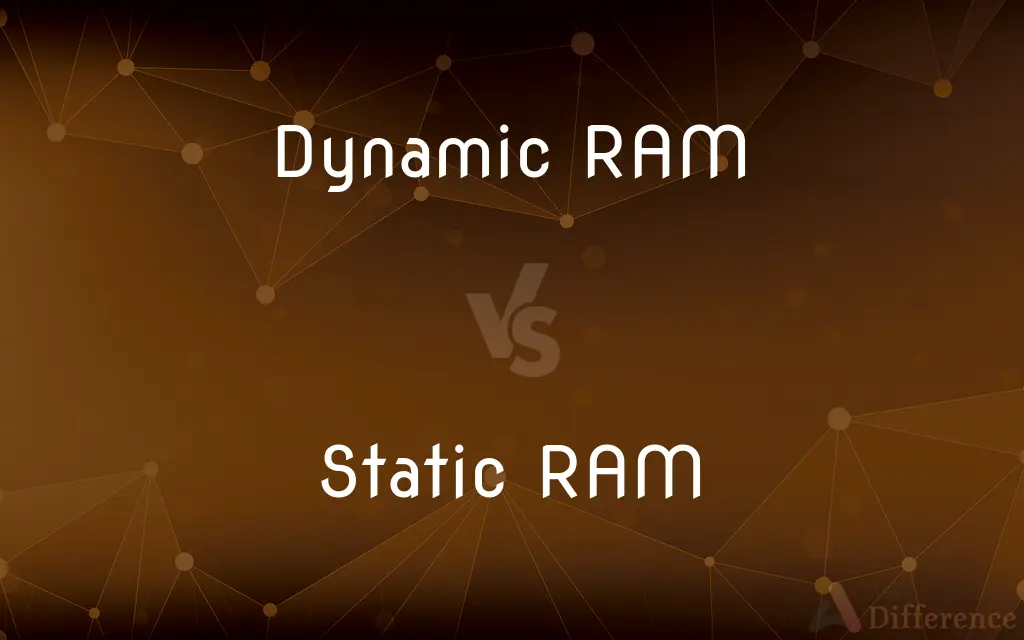Dynamic RAM vs. Static RAM — What's the Difference?
By Tayyaba Rehman — Published on December 26, 2023
Dynamic RAM (DRAM) needs periodic refreshing to retain data, while Static RAM (SRAM) holds data without refreshing, making it faster but more expensive.

Difference Between Dynamic RAM and Static RAM
Table of Contents
ADVERTISEMENT
Key Differences
Dynamic RAM (DRAM) is a type of memory that requires constant power and periodic refreshing to maintain its content. Static RAM (SRAM), on the other hand, retains its content as long as power is supplied, without the need for refreshing.
Dynamic RAM uses a single capacitor and transistor to represent each memory cell, making it simpler and more cost-effective. However, because capacitors leak, DRAM needs refreshing. Static RAM uses multiple transistors for each memory cell, making it more complex and pricier.
Speed is a notable distinction. Dynamic RAM typically has slower access times compared to Static RAM. Since SRAM doesn't require periodic refresh cycles, its operations are generally faster.
In terms of applications, Dynamic RAM is predominantly found in main system memory due to its cost-effectiveness and higher density. Static RAM is commonly used for cache memory in CPUs because of its speed.
Power consumption is another factor. Dynamic RAM consumes more power during operations because of the constant refreshing. Static RAM, without the need for refreshing, generally consumes less power during operations.
ADVERTISEMENT
Comparison Chart
Memory Retention
Needs refreshing
Retains without refreshing
Cell Composition
Single capacitor and transistor
Multiple transistors
Speed
Generally slower
Faster
Application
Main system memory
CPU cache memory
Power Consumption
Higher due to refreshing
Lower as no refreshing is needed
Compare with Definitions
Dynamic RAM
A slower, more dense, and cost-effective RAM compared to Static RAM.
Most of the system's memory is made up of Dynamic RAM due to its affordability.
Static RAM
A memory type that holds data without needing refreshing.
CPUs often have Static RAM for cache because of its quick access times.
Dynamic RAM
Memory that consumes more power because of its refreshing needs.
Power consumption is higher in Dynamic RAM because of its constant refreshing.
Static RAM
A faster but less dense RAM compared to Dynamic RAM.
For speed-critical applications, Static RAM is the preferred choice.
Dynamic RAM
The common RAM found in computers and laptops for main memory.
My computer has 16GB of Dynamic RAM for multitasking.
Static RAM
Often used in devices where speed is crucial, like in cache memory.
The processor's cache uses Static RAM for faster data access.
Dynamic RAM
A memory type requiring periodic refreshing to retain data.
Computers use Dynamic RAM for their primary memory because of its cost-effectiveness.
Static RAM
Memory constructed with multiple transistors per cell.
The design of Static RAM with several transistors makes it more expensive.
Dynamic RAM
Memory with cells consisting of a capacitor and a transistor.
The capacitors in Dynamic RAM leak, necessitating frequent refresh cycles.
Static RAM
Memory that generally consumes less power than Dynamic RAM during operations.
Static RAM is power-efficient since it doesn't require refresh cycles.
Common Curiosities
Why does Dynamic RAM need refreshing?
It uses capacitors that leak charge, necessitating refreshing to maintain data.
Can I find Static RAM in regular computer systems?
Yes, typically as cache memory in the CPU for faster data access.
Is Dynamic RAM the primary memory in most computers?
Yes, due to its higher density and affordability.
Is Dynamic RAM cheaper than Static RAM?
Yes, Dynamic RAM is more cost-effective due to its simpler design.
Can I upgrade Dynamic RAM in my laptop?
Typically yes, many laptops allow Dynamic RAM upgrades for better performance.
What is the main difference between Dynamic RAM and Static RAM?
Dynamic RAM needs periodic refreshing, while Static RAM retains data without refreshing.
Which RAM is faster in operation?
Static RAM is generally faster than Dynamic RAM.
Why is Static RAM used for CPU cache?
Due to its speed and the ability to retain data without refreshing.
Which RAM consumes more power?
Dynamic RAM typically consumes more power because of its need for refreshing.
Which RAM is more dense?
Dynamic RAM is more dense compared to Static RAM.
Does Static RAM need a constant power supply?
Yes, but it doesn't require refreshing like Dynamic RAM.
How is the cell design different between Dynamic RAM and Static RAM?
Dynamic RAM uses a capacitor and transistor, while Static RAM uses multiple transistors.
Is Static RAM more reliable for critical operations?
Yes, because it doesn't require refreshing and offers faster access times.
Why is Static RAM more expensive?
It uses multiple transistors per memory cell, making it more complex and costly.
Why is Static RAM not used as the main system memory?
It's less dense and more expensive than Dynamic RAM, making it impractical for large-capacity needs.
Share Your Discovery

Previous Comparison
Collusive Oligopoly vs. Non-Collusive Oligopoly
Next Comparison
Regular Expression vs. Context Free GrammarAuthor Spotlight
Written by
Tayyaba RehmanTayyaba Rehman is a distinguished writer, currently serving as a primary contributor to askdifference.com. As a researcher in semantics and etymology, Tayyaba's passion for the complexity of languages and their distinctions has found a perfect home on the platform. Tayyaba delves into the intricacies of language, distinguishing between commonly confused words and phrases, thereby providing clarity for readers worldwide.












































